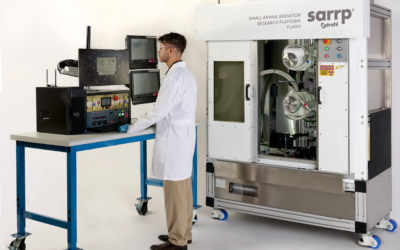Cancer is a complex disease, with a variety of approaches available for its treatment. Treatment modalities are often combined to maximize response and to overcome the limitations of individual modalities when used alone. One such example is the combination of radiotherapy with hyperthermia, i.e. non-ablative sustained heating for the treatment of radiation-resistant tumours, or tumour sub-regions. Heat has a radio-sensitizing effect on cell lines of both normal and malignant origin. Heating applied locally to a tumour may therefore enhance treatment outcome without increasing the risk of normal tissue complications. Up to now this approach has not been well studied and there have been few studies reporting the effects of combination treatments of radiation and heat.
In their article “Combining radiation with hyperthermia: a multiscale model informed by in vitro experiments” S. Brüningk, G. Powathil, P. Ziegenhein, J. Ijaz, I. Rivens, S. Nill, M. Chaplain, U. Oelfke and G. ter Haar present an implementation of a hybrid cellular automaton model which simulates the response of cells to heat, radiotherapy or combinations of the two, on several different spatio-temporal scales.
The model presented here is a cellular automaton model for the simulation of response to therapy using the recently developed AlphaR survival model designed specifically for calculating cell surviving fractions after multimodality treatments.
For treatments, cells were detached, concentrated to give a suspension of 5 × 106 cells ml−1 and transferred to sterile, thin-walled PCR tubes in 60 μl volumes. For irradiation, tubes containing cells were embedded in a solid water sample holder and irradiated using a small animal radiation research platform (SARRP) at a dose rate of 63 mGy s−1. Heating to 46°C for 5 min was performed in a Biorad Tetrad2 DNA Engine PCR thermal cycler (Hercules). Cells were kept on ice before, between and after treatments to minimize cellular activity during waiting periods. For combination treatments, cells were first irradiated, and then heated within 20 min of this irradiation. It was confirmed experimentally that if heating was applied within 30 min, the delay between irradiation and heating made no difference to the subsequent clonogenic cell survival. For fractionated treatments, plates seeded with the required number of cells were irradiated every 24 h using an Xstrahl X-ray cabinet, dose rate 63 mGy s−1.
The authors have demonstrated that a cellular automaton model that is suitable for accurate modelling of the dynamic response to separate, or combined, heat and radiotherapy treatments. The inclusion of delayed rather than instantaneous, cell kill after irradiation may impact on simulations which aim to study the effects of reoxygenation and tumour progression, and should therefore be taken into account. There was presented a simple implementation for enabling such modelling. The framework was verified against a consistent experimental dataset thus making this simulation framework a reliable basis for future applications where the effects and optimized treatment protocols for combination treatments in vivo are studied.
This Xstrahl In Action was adapted from a article found on a National Library of Medicine website.






